Evaluation of Coloured Containers as Attractants to Gravid Mosquitoes for Oviposition
Njila HL1*, Sani HS1, Ombugadu A2 and Tanko NS3
1Department of Science Laboratory Technology, University of Jos, P. M. B. 2084 Jos, Plateau State, Nigeria
2Department of Zoology, Faculty of Science, Federal University of Lafia, P. M. B. 146, Lafia, Nasarawa State, Nigeria
3Department of Chemistry, Faculty of Science, Federal University of Lafia, P. M. B. 146, Lafia, Nasarawa State, Nigeria
Submission: February 07, 2023; Published: February 28, 2023
*Corresponding author: Njila HL, Department of Science Laboratory Technology, University of Jos, P. M. B. 2084 Jos, Plateau State, Nigeria, Tel: +2348163365257
How to cite this article: Njila HL, Sani HS, Ombugadu A and Tanko NS. Evaluation of Coloured Containers as Attractants to Gravid Mosquitoes for Oviposition. Trends Tech Sci Res. 2023; 6(1): 555679. DOI: 10.19080/TTSR.2023.06.555679
Abstract
Selection of oviposition sites by female mosquitoes is crucial for the survival of their progeny. Thus, a study to evaluate Coloured containers as attractants that influence oviposition and development of mosquitoes in relation to some physicochemical parameters was carried out. Two liters plastic containers of different colours were filled with equal amounts of water and placed at ground level in the garden under full shade at 5cm interval. The colours were placed alphabetically as follows; black, blue, brown, green, pink, purple, red, white and yellow. The containers were observed daily for 30 days. On each day all the containers were carefully observed for the occurrence of mosquito larvae. There was no significant difference (P > 0.05) in the colour cues as attractants to influencing oviposition and development of mosquito species. The colour cues which attracted the most abundant mosquitoes for oviposition are in the order Red > Purple > Pink > Brown > White. There was a significant difference (P < 0.05) in the abundance of mosquitoes attracted for oviposition in relation to the coloured containers. A total of 290 mosquito larvae were collected from the nine breeding containers. Aedes species were the most abundant mosquito species that utilized all the nine man-made coloured containers for oviposition. While Culex species were the least abundant and utilized only red, black, yellow, and purple containers for oviposition. Water physicochemical parameters favours the attraction of mosquitoes for oviposition. Therefore, getting the right information about the colours cues and water factors that attract mosquito species for oviposition will help in reducing mosquito abundance.
Keywords: Oviposition; Mosquitoes; Containers; Colour Affinity
Introduction
Oviposition site selection by gravid mosquitoes is one of the crucial events in non-parental organisms [1]. In mosquitoes, the reproductive success depends on the ability of a mosquito to search for the suitable oviposition site that will ensure survival for the progeny [2]. Habitat related chemical cues have been shown to play an important role in the oviposition site selection by gravid female mosquitoes [3]. Anopheles gambiae and Culex quinquefasciatus mosquitoes are anthropophilic thus, highly associated with habitats close to human dwellings [4]. Anopleles arabiensis mosquitoes in particular are anthropophilic or zoophilic depending on geographical location and host availability [5,6]. In different areas, Cx. quinquefasciatus have been found lying egg rafts in habitats with higher levels of organic pollutants [7]. While An. gambiae and An. arabiensis have been found to lay eggs in turbid small water pools with short vegetation or without vegetation. Micro-organisms inhabiting mosquito breeding sites have been found to play a major role in the decomposition of detritus and other nutrients present in these habitats, leading to the production of several metabolites emanating different chemical cues [8].
Gravid mosquitoes are often attracted to water in spite of the fact that the decision to lay eggs may depend on additional olfactory signals or other stimuli received when the insect lands on the water surface [9]. Therefore, interruption of oviposition site selection for mosquitoes may lead to Population growth reduction and have a positive impact in control programmes [10]. An understanding of the biological factors associated with mosquito oviposition provides opportunities for the design of highly effective, species-specific mosquito surveillance and control protocols [11]. Many factors may delay mosquito oviposition Abiotic factors including wind, moon phase, relative humidity, temperature, and the amount of standing water affect the timing of oviposition [12]. Thus this work is to evaluate coloured containers as attractants that influence oviposition and development of mosquitoes in relation to some physicochemical parameters.
Materials And Methods
Study Area
The study was conducted within the ecological station of the University of Jos, Bauchi Road campus located on Latitude 09°57´01ʺ N and Longitude 08°53´21ʺ E Jos North LGA of Plateau State, Nigeria.
Experimental Containers
The experimental Containers were arranged in the rainy season of September-November, 2019. Two liters plastic containers of different colours were filled with equal amounts of water and placed at ground level in the garden under full shade at 5cm interval. The colours were placed alphabetically as follows; black, blue, brown, green, pink, purple, red, white and yellow. The containers were observed daily for 30 days.
Observation and Collection of Mosquitoes
On each observation day all the content of each container were carefully, if they are positive with larvae, then a pipette was used to transfer all the larvae into a clean empty bowl containing some water and labeled according to the colours of the containers. All the bowls were taken to the insectary for rearing to adult stages.
Mass Rearing and Identification of Mosquitoes
In the insectary, the larvae were counted and placed in plastic bowls inside mosquito cages (61cm x 61cm x 61cm). Mean temperature of (27±2) ℃ and relative humidity of 70% - 80% was maintained in the insectary. The larvae were fed with larval food (dog biscuit and yeast at a ratio 3:1, w/w). The larvae were fed twice daily, and the water changed after 48 hours, until the adult emerge. The adult mosquitoes were then fed on 100 g/L glucose solution. This serves as food source for the emerging adults. Adults were observed under a dissecting microscope and identified, the type of mosquito genera according to keys provided by Gillies and Coetzee [13].
Determination of Physicochemical Parameters
Water temperature (℃) in each container was monitored daily with mercury in glass thermometer and the Hydrogen ion concentration (pH) was monitored with a Hanna scientific pH meter. Dissolved oxygen, free carbon and alkalinity (mg/L) of the water samples were determine using direct titration technique.
Statistical Analyses
Data were analyzed using the Statistical Package for Social Science (SPSS) version 25. Chi-square was used to investigate colour cues as attractants influencing oviposition and development of mosquito species. One-way analysis of variance (ANOVA) was used to determine the species composition and abundance of mosquitoes that utilized man-made containers for oviposition and to determine water physicochemical parameters in relation to different coloured container used for oviposition. P < 0.05 was regarded as the acceptable level of significance. while P > 0.05 was not significant at 5%.
Results
Colour Cues as Attractants Influencing Oviposition and Development of Mosquito
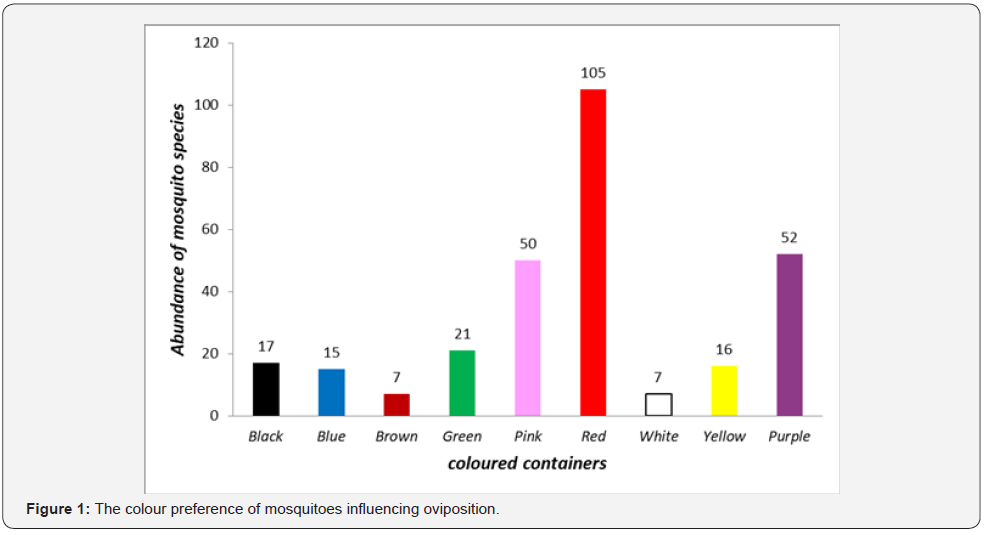
There was no significant difference (χ2 = 8.00, df = 8, P > 0.05) in the colour cues as attractants influencing oviposition and development of mosquito species (Figure 1). The colour cue which attracted the most abundant mosquitoes for oviposition are in the order Red, Purple, Pink, Brown and White (Figure 1). There was a significant difference (F = 23.64, df = 8, P < 0.05) in the abundance of mosquito species attracted for oviposition in relation to coloured containers (Figure 2). A total of 290 mosquito larvae were collected from the nine breeding containers. The result showed that 284 individuals representing 97.93% were Aedes species and 6 (2.07%) Culex species (Figure 2). From the result, Aedes species were the most abundance mosquito species and utilized all the nine coloured containers for oviposition.
The breakdown of the result depicted 102 representing 35.92% were collected from Red container, 16 (5.63%) Black container, 15 (5.28%) Yellow container, 51(17.96%) Purple container, 21 (7.39%) Green container, 50 (17.61%) Pink container, 15 (5.28%) Blue container, 7 (2.46%) Brown and White containers respectively (Figure 2). On the other hand, Culex utilized only four of the coloured containers for oviposition. Out of the total of 6 Culex species collected, 3 representing 50.00% were collected from red container, 1 (16.67%) Black container, 1 (16.67%) Yellow container, 1 (16.67%) Purple container and none was recorded in Blue, Brown, Green, Pink and White containers respectively (Figure 2).
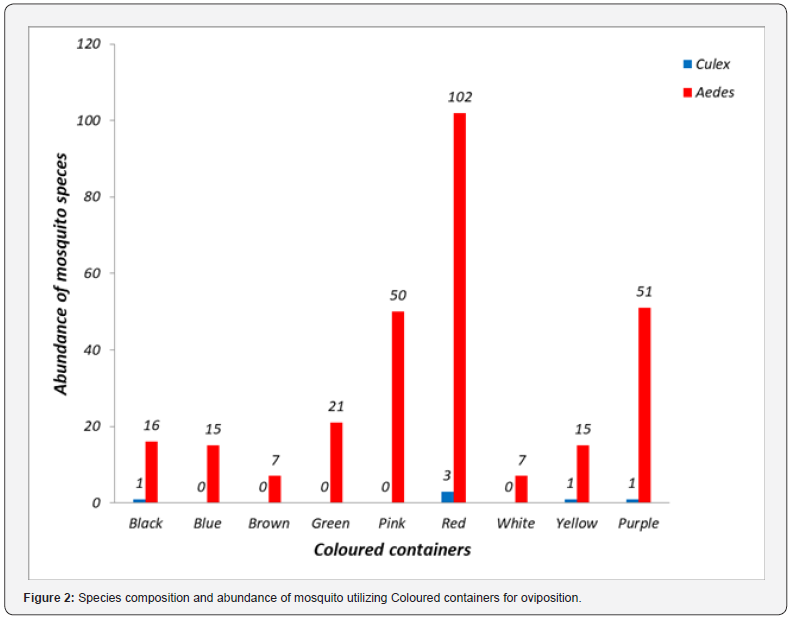
Determination of Physicochemical Parameters
There was no significant difference (F = 6.24, df = 8, P > 0.05) in the water temperature in relation to the nine coloured containers (Figure 3). The temperature ranged from 23.5 ℃ in Purple, Yellow and Brown to 27.5 ℃ in Blue and Pink containers (Figure 3). There was also no significant difference (F = 0.41, df = 8, P > 0.05) in the water pH in relation to the nine coloured containers (Figure 4). The pH ranged from 8.5 in Pink container to 7.70 in Purple container (Figure 4). There was a significant difference (F = 4.25, df = 8, P < 0.05) in the dissolved oxygen concentration in relation to the nine coloured containers (Figure 5).
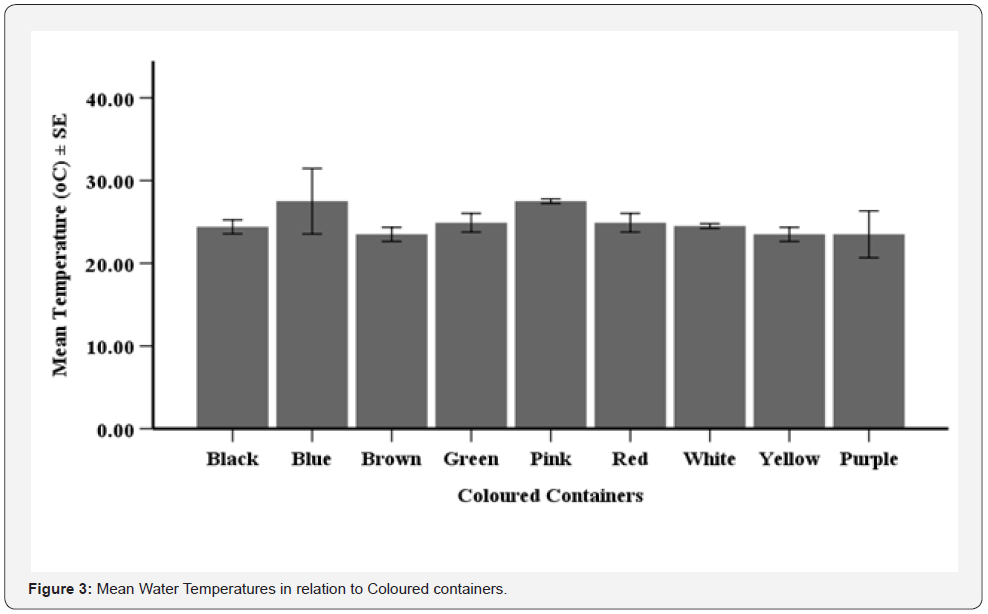


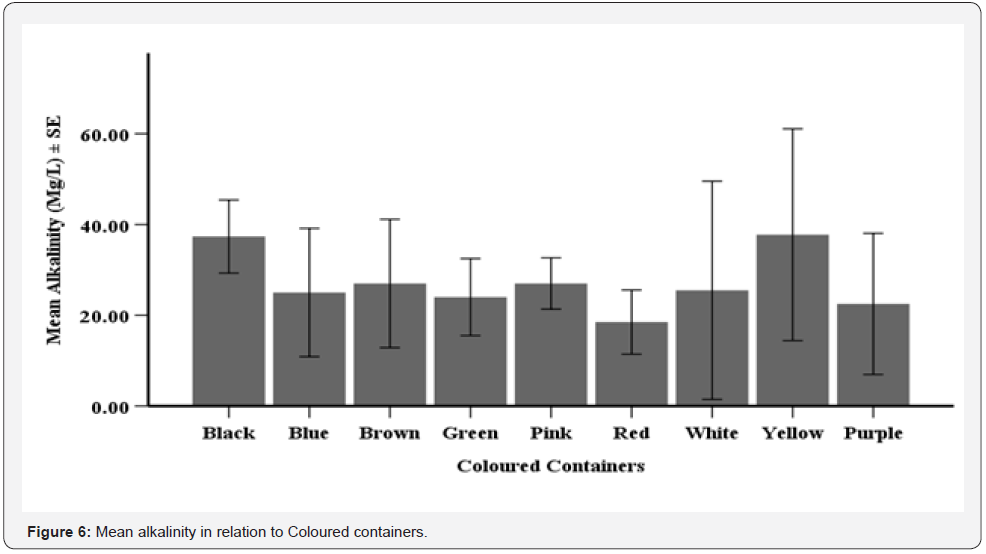
The dissolved oxygen ranged from 10.1mg/L in red container to 7.1mg/L in Brown container (Figure 5). There was no significant difference (F = 1.49, df = 8, P > 0.05) in water alkalinity in relation to the nine coloured containers (Figure 6). The alkalinity ranged from 37.75mg/L in Yellow container to 18.5mg/L in Red container (Figure 6). There was a significant difference (F = 4.94, df = 8, P < 0.05) in free carbon concentration in relation to the nine coloured containers (Figure 7). The free carbon ranged from 3.5mg/L in Pink and Black container to 0.5mg/L in green containers (Figure 7).
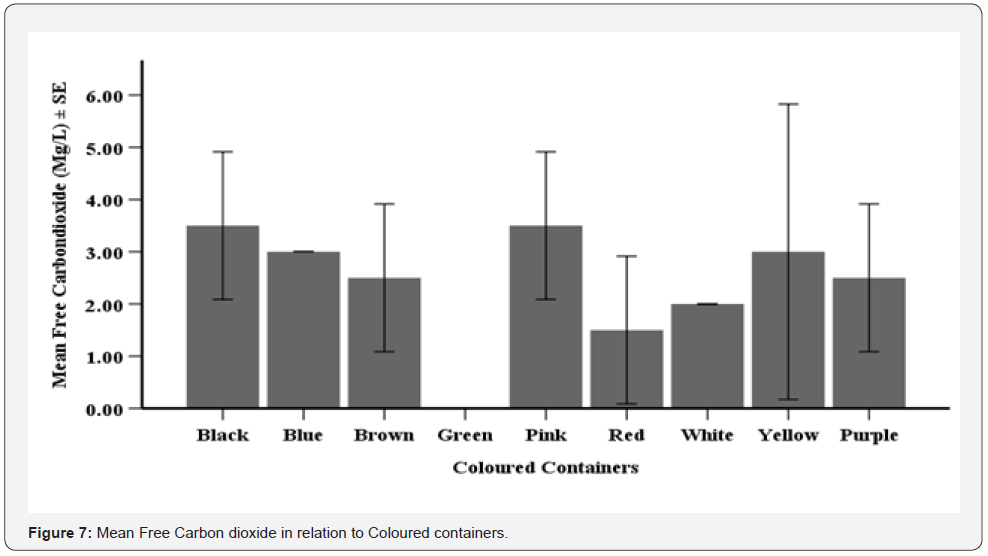
Discussion
Colour Cues as Attractants Influencing Oviposition and Development of Mosquitoes
Selection of preferred site for oviposition is an important factor for female mosquitoes to ensure survival of their larvae. Female mosquitoes follow visual or olfactory cues, appropriate water conditions, chemical cues and physical factors in the water before making decision to lay their eggs [14]. Similarly female mosquitoes select colour containers for oviposition base on their reflectance properties [15]. Red colour container in this study was the most preferred container for oviposition and this could be attributed to the degree of light absorption by the red container. This is supported by the report of Collins and Blackwell [16] who reported that red colour absorb more light across a wide visible spectrum than other colours, thus facilitating the attraction of several mosquito species.
This is also in agreement with the study conducted by Badamasi et al. [17] where red container was the most attractive for oviposition. Similar result was reported by Dibal et al. [18] where they observed that red cup containing cow dung is most preferred by different species of mosquitoes for oviposition. In these study, the red colour was mostly preferred by Aedes species and this could be due to the degree of the sensitivity of their eyes to light. This is supported by the findings of Muir et al. [19] who reported that spectral sensitivity of the eyes of female Aedes aegypti range from ultraviolet (323nm) to orange red (621nm) wavelengths. They also reported that the eyes of female Aedes aegypti have relatively poor sharpness and is capable of some wavelength discrimination but with high overall sensitivity to light. Aedes and Culex mosquitoes were the only species collected in all the coloured containers and this was attributed to their ability to breed in containers. This is in consistent with the findings of Irving-Bell et al. [20] who observed that Aedes and Culex are highly adapted to container-breeding. Also, Bing et al. [14] also reported high occurrence of Aedes larvae in domestic utensils and man-made plastic containers.
Aedes species was the most abundant species collected in all the coloured containers and this was due its diurnal nature and because the study area is highly populated by students whose lecture time is during the daytime which enable the mosquitoes to obtain sufficient blood meal necessary for oviposition. WHO [21] reported that the peak biting periods for Aedes mosquitoes are early in the mornings and in the evenings before dusk. In this study the species with the least occurrence is Culex species which utilized only four containers with minimal number of larvae as compared to Aedes. This low abundance may be due to insufficient blood meal due to their nocturnal nature thus affecting the rate of oviposition. This is consistent with the findings of Mwangi [22] and WHO [23] who reported that Culex mosquitoes bites mostly at night.
Determination of Physicochemical Parameters
Prevailing physicochemical parameters in a habitat are important factors for survival and development of mosquitoes [24]. The water temperatures recorded in this study ranges from 27- 28℃ which favored the attraction of Aedes species for oviposition. This is supported by the findings of American Pest [25] who reported that within the water temperatures of 20 and 30°C Aedes species do not discriminate between changes in water temperature as indicated by the number of eggs laid. Amerasinghe et al. [26] also reported that water temperature of 27°C and 28°C are ideal for mosquito’s oviposition. The water pH of 7.3 - 8.8, which are slightly alkaline throughout the study is within the range considered favorable for oviposition as reported by Osta et al. [27].
He reported that naturally mosquitoes breed in surface waters with pH of 6.5-8.5. Thus the pH of the water had a positive relationship with the abundance of mosquitoes recorded. This also confirmed the report of Preet [28] that mosquitoes usually breed in slightly alkaline water. The highest dissolved oxygen value obtained in this study is in the red-coloured container. This indicates that increasing dissolved oxygen favours the attraction of mosquitoes for oviposition. This was also reported by Nazri et al. [29] who stated that number of mosquito larvae increases with increase in dissolved oxygen. Oram [30] stated that alkalinity of water is the capacity of that water to resist changes in pH which would make the water more acidic. In this study the alkalinity of 18.5 to 37.75 mg/L is within the optimum range for the development of mosquito species [31]. The free carbon ranged of 0.5-3.5mg/L recorded in this study is low and thus affected the attraction of mosquitoes negatively [25].
Conclusion
Different mosquito species have different preference for oviposition site. In this study, red container was the most preferred for oviposition by female mosquito species. Aedes species are the most abundant species of mosquitoes collected. Data obtained from water physicochemical parameters revealed that warm temperature, slightly alkaline pH, increasing level of dissolved oxygen, moderate range of alkalinity and increasing free carbon in the water favours the attraction of mosquito species for oviposition. However, the resultant attraction of ovipositing females is as a result of the positive correlation between the coloured containers and physicochemical parameters. Therefore, it is recommended that the status of these containers vis-à-vis the physicochemical parameters in the urban and rural settlements as major breeding foci of mosquitoes needs further investigation to determine their actual vectorial importance.
References
- Blaustein L, Kiflawi M, Eitam A, Mangel M, Cohen JE (2004) Oviposition habitat Selection in response to risk of predation in temporary pools: mode of detection and consistency across experimental venue. Oecologia 138(2): 300-305.
- Afroza S, Sharmin H, Mosharraf H, Abdul A, Mohammad A, et al. (2017) Larval Breeding Habitats and Ecological Factors Influence the Species Composition of Mosquito (Diptera: Culicidae) in the Parks of Dhaka City, Bangladesh. Bangladesh J. Zool 45(2): 111-122.
- Braks MA, Leal WS, Carde RT (2007) Oviposition responses of gravid Female Culex quinquefasciatus to egg rafts and low doses of oviposition pheromone under semi field conditions. J Chem Ecol 33(3): 567-578.
- Ombugadu A, Jibril AB, Mwansat GS, Njila HL, Attah AS, et al. (2022) Composition and Distribution of Mosquito Vectors in a Peri-Urban Community Surrounding an Institution of Learning in Lafia Metropolis, Nasarawa State, Central Nigeria. Journal of Zoological Research 4(3): 20-31.
- Coetzee M, Craig M, le Sueur D (2000) Distribution of African malaria mosquitoes Belonging to the Anopheles gambiae complex. Parasitol Today 16(2): 74-77.
- Walton WE, Van Dam AR, Popko DA (2009) Ovipositional responses of two Culex (Diptera: Culicidae) species to larvivorous fish. J Med Entomol 46(6): 1338-1343.
- Eiras AE, Buhagiar TS, Richie SA (2014) Development of the gravid Aedes trap for the capture of adult female container-exploiting mosquitoes (Diptera: Culicidae). J Med Entomol 51(1): 200-209.
- Thavara U, Tawatsin A, Chompoosri J (2004) Evaluation of attractants and egg-laying Substrate preference for oviposition by Aedes albopictus (Diptera: Culicidae). Journal of Vector Ecology 29(1): 66-72.
- Choo YM, Buss GK, Tan K, Leal WS (2015) Multitasking roles of mosquito labrum in oviposition and blood feeding. Front Physiol 6: 306.
- Ritchie SA, Long S, Hart A, Webb CE, Russell RC (2013) An adulticidal sticky ovitrap for sampling container-breeding mosquitoes. J Am Mosq Control Assoc 19(3): 235-242.
- Mackay AJ, Amador M, Barrera R (2013) An improved autocidal gravid ovitrap for the Control and surveillance of Aedes aegypti. Parasites Vectors 6(1): 225-237.
- Chaves LF, Kitron UD (2011) Weather variability impacts on oviposition dynamics of the southern house mosquito it intermediate time scales. Bull Entomol Res 101(6): 633-641.
- Gillies MT, Coetzee MA (1987) Supplement to the Anophelinae of Africa South of the Sahara. Publication of South African Insttitute of Medical Research 55: 1-143.
- Bing CK, Chua LE, Hsiang KC (2004) Differential preferences of Oviposition by Aedes Mosquitoes in man-made containers under field conditions. Southeast Asian J Trop Med & Public Health 35(3): 599 -606.
- Wan FZ, Maniam T, Nik F (2016) Colour cues: Effects of Ipomoea plant extract on Culex Quinquefasciatus Say gravid females in choosing oviposition site. Tropical Life Sciences Research 27(2): 91-102.
- Collins LE, Blackwell A (2000) Colour cues for oviposition behavior in Toxorhynchites moctezuma and Toxorhynchites amboinensis mosquitoes. J Vector Ecol 25(2): 127-135.
- Badamasi MZ, Adamu T, Bala AY (2008) Species Abundance and Colour Preferences of Oviposition by Mosquitoes in Man-Made Containers under Field Conditions in Sokoto, Nigeria. Nigerian Journal of Basic and Applied Sciences 16(2): 193-196.
- Dibal DB, Nok IN, Umar YA (2012) Effect of colour, cow dung and clay suspension on Oviposition behavior of gravid female mosquitoes in Zaria, Kaduna state, Nigeria. International Research Journal of Microbiology 2(6): 223-226.
- Muir LE, Thorne MJ, Kay BH (1992) Aedes aegypti (Diptera: Culicidae) vision: Spectral sensitivity and other perceptual parameters of the female eye. Journal of Medical Entomology 29(2): 278-281.
- Irving-Bell RJ, Inyang EN, Tamu G (1991) Survival of Aedes vittatus (Diptera: Culicidae) eggs in hot dryrockpools. Trop Med Parasitol 42(1): 63-66.
- WHO (2017) Dengue Control. Geneva, Switzerland.
- Mwangi T (2017) Debunking myths about malaria and its vector, the mosquito.
- WHO (2018) Zika Virus. Geneva, Switzerland.
- Okwa O, Savage AA (2018) Oviposition and breeding water site preferences of mosquitoes within Ojo area, Lagos State Nigeria. Biomedical Journal of Scientific & Technical Research 7(5): 6139-6145.
- American Pest (2020) Who and What Attracts Mosquitoes?
- Amerasinghe FP, Indrajith DG, Ariyasena TG (1995) Physicochemical characteristics of mosquitoes breeding habitats in an irrigation development area in Sri-Lanka. Cey Journal of Science 24(2): 13-29.
- Osta FM, Burket TR, Andre RJ (2004) Behavioral aspects of Mosquito. Annual Revision of Entomology 34: 401-421.
- Preet S (2017) Water quality and mosquitoes?
- Nazri CD, Muhammad FM, Siti NAH, Nurlisa M (2016) Water quality characteristics of dengue vectors breeding containers. International Journal of Mosquito Research 3(1): 25-29.
- Oram B (2014) Alkalinity.
- Ukubuiwe AC, Ojianwuna CC, Olayemi IK, Arimoro FO, Ukubuiwe CC (2020) Quantifying the roles of water pH and hardness levels in development and biological fitness indices of Culex quinquefasciatus Say (Diptera: Culicidae). The Journal of Basic and Applied Zoology 81: 5.






























